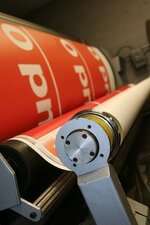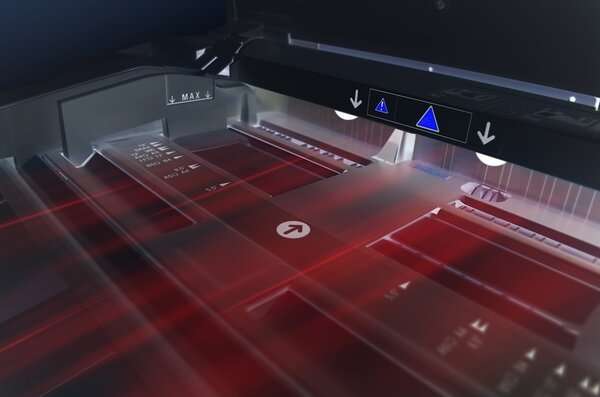If you are new to a vinyl cutter or sublimation, then don’t worry. Our guide will help you out on how to use your vinyl cutter for sublimation.
A vinyl cutter is a machine that is used for trimming vinyl into different shapes. You can use your computer to provide the machine with a design to cut. Connect your vinyl cutter with your computer using a USB link, and your machine will cut any design you provide it with.
This process is very similar to what you do in dye sublimation. But you are limited in dye sublimation, which is not the case when dealing with vinyl.
We will talk all about it in this guide, so keep reading.
What is a Vinyl Cutter and What It Can Do?

It is an entry-level machine that you can use for making signs. You will need your computer to connect with this cutter to transfer those vector files with letters and signs. The machine is directly cut on a vinyl roll that you mount and feed into your cutter machine.
This vinyl cutter machine is used for advertisements, banners, and signs. For example, the ads that you see on vans and automobiles are created using these vinyl cutters.
Apart from vinyl, you can use these cutter machines to cut through the specialty of computer papers. Furthermore, you can use these cutter machines to cut through thin sheets of magnet thicker than any piece of a paper sheet.
Not only that, you can use these vinyl cutter machines for apparel design and decoration. You need to cut a vector design in its mirror images (just like you would do in sublimation) and then weeded.
In the end, you will have to apply heat using a commercial heat press. You can also use a hand iron if you are working on a DIY project at home.
Some businesses use their vinyl cutters for apparel decorations and sign production. In contrast, some people use these cutters in their homes. It is because these machines do not need much maintenance.
Plus, you can purchase a vinyl in bulk at a cheaper cost. Many stencil artists use vinyl cutters to create their lettering and stencil art either for single use or reusable purposes.
How Does a Vinyl Cutter Work?

A vinyl cutter looks like your desktop printer. Like a printer has its nozzle, a vinyl cutter for sublimation has a sharp blade right over the surface of the materials you want to cut.
With this blade, the vinyl cutter cuts out different letters and shapes. The vinyl sheet is thin but self-adhesive plastic. Hence, you can use it to stick on other surfaces based on the type of materials and the adhesive.
For cutting the design out, you will need a vector image with the help of a vector software program. Some vinyl cutters come with their software programs, while others can be used with a different one.
Once the design is created, it is sent to the cutter, which starts cutting along the vector path in the design. For example, a vinyl cutter for sublimation can cut with its blade on an X and Y-axis plane on that material. Hence, it can cut any shape or design that you can create using the software programs.
Vinyl material is also available in long rolls. As a result, you can work on a variety of projects that involve large banners and billboards.
But if you are working on a design that has multiple colors in it. You will have to cut out each color separately. After that, you will have to layer each one on top of the other and apply the substrate. It is most commonly referred to as stencil art.
As you are dealing with the layering of different solid colors to create a multicolor design, you will not be able to create photographs or work with gradients using your standalone vinyl cutter for sublimation.
It is a major setback that you have to deal with when using a vinyl cutter for sublimation.
Positives & Negatives of Using Vinyl Cutter
Pros
- You are not limited to working with polyester.
- Working with cotton and cotton blended fabrics is an option too.
- You can work with darker-colored fabrics too. But, unfortunately, both of these tasks are not possible when you are going for sublimation.
Cons
- You will have to do additional work on your design (weeding) to create a finished look.
- A vinyl cutter can only handle a few layers of colors. So you will have to stack each solid color cutting to create that multicolor effect.
- You cannot print photographs and multi-colored images using your vinyl cutter.
How to Use a Vinyl Cutter?

Using your vinyl cutter is not that difficult. But you will need quality vinyl-cutting software programs. Make sure to go for any program that deals in vector designing. Therefore, your first choice here should not be Adobe or similar photographic or imagine software programs.
You need to go for a program like CorelDraw, Inkscape, or similar other software programs to create your designs. After that, you will have to hook your vinyl cutter machine with your computer. Usually, you can do that with a USB cable. From there, you can send your designs to your vinyl cutter.
You will have to feed your cutter using vinyl sheets with different colors to create multiple color designs. Give the print, and your cutter will start running the blade right over the design marks.
The cut-out will be created after a while. But first, you will have to do weeding and get rid of the access paper that is not part of the design. And from there, you have the design that you can transfer onto any other material.
Vinyl Cutters vs. Vinyl Cutter Printers (Vinyl Plotters)
These vinyl cutter printers are also called vinyl plotters. They work just like vinyl cutters, but they are used differently. A vinyl plotter has a pencil or a market or any other writing tool instead of a blade. Therefore, it only draws the design and doesn’t make any cuts.
Vinyl cutters have blades or knives that cut and make designs, and they do not draw or plot any design on vinyl. Still, all cutters can function as plotters and replace the blade with a pen or a market attachment.
But not all plotters can cut. These plotters are different from printers as they sketch the design with a pen that has a single color. Therefore, it can only plot a single color at a time.
Printers have ink cartridges that create that image on the paper by connecting the dots on paper. However, color printers can produce images as they can deal with multiple colors.
Vinyl Cutter Types Based on Usage
Home use
These vinyl cutters are designed for light use. Hence, they are excellent for startups, home use, and hobbyists. Nonetheless, these are cheaper units, and they cannot work on larger printing surfaces. They also do not come with the appropriate settings for many businesses.
This cutter is a top voice for working on small designs. So, they are not going to take up much space. Plus, they do not support too many materials and operating systems.
Small shop or mid-pro
These cutters can work on larger surfaces and support more materials than their home-use counterparts. So, they are suitable for professionals who are working on a smaller scale. Plus, these cutters can deal with most midscale cutting requirements.
Therefore, they work well for most businesses and can cut through thicker and more challenging materials. But they do cost more than their home-use counterparts. Plus, they come with different innovative features.
Commercial use
The third type of vinyl cutters is the commercial ones. These are suitable for large-scale projects and can handle larger printing surfaces. And these cutters can handle precise cuts and can deal with more intricate cutting details.
They have numerous features that the other two types do not come with. For example, commercial vinyl cutters can work with different operating systems and software programs and are highly versatile. But these vinyl cutters are pretty expensive too.
Vinyl Cutter Types Based on Design
Roll feed

These cutters come with aha designs that look like “T,” particularly when looking at them from either side. Besides that, they have a floor stand integrating into the design; this design gives them a sturdy and solid base.
It can cut crafts from a roll of different materials. It saves you money because you are not using sheets. You can feed these cutters with rolls of materials. It helps in pushing the media right along the blade and cuts the design out.
These cutters roll continuously and cut media that fall into a catch basket. They have a design that ensures an easier installation, and it saves production space too. Roll feed cutters are available in different sizes. They can support a 50-foot length and are useful for long-cut applications.
Flatbed

These cutters have a flatbed or a table platform, and they use it for completing different cutting jobs. You need to place media on that work table, and the cutter will move the blade over the material surface when the design is. They produce the prints just like a traditional desktop printer does.
This unit is a top choice for hard materials that you cannot friction-feed or roll feed. Some models can even cut up 0.75 inches. Hence, they are excellent for carving intricate designs on different materials.
These include cardboards, oil boards, photo-masking films, foam materials, and sand-blast-resistant rubber. These cutters are available in different sizes too. But these cutters are slightly more expensive than roll feed cutters.
Desktop
Like the roll feed vinyl cutters, these desktop cutters also have rollers. You can friction-feed the materials into your machine for various projects. But, again, these units don’t need a stand, and you can place them on your desk.
They can cut through different sheets of materials. Some models can even cut through different rolls of materials in length. Besides that, these cutters are available in different sizes too and are much cheaper. Furthermore, they have compact and lightweight designs, and you can transport them conveniently.
Features to Consider for Vinyl Cutters
There are different features that you need to consider when buying a vinyl cutter for sublimation. Here are some of the features you must keep in mind when looking for vinyl cutters:
Cutting area
You have to choose your vinyl cutter for sublimation based on its cutting area. So, first, make a selection based on the spec available in your work area, and then go for the appropriate size.
You will also need to pick the right size based on the materials that fit into your machine. Hobbyists can go for smaller cutters, while professionals can go for the larger units to work on larger projects.
Speed
The speed of these vinyl cutting machines can determine how fast they can cut and complete a job. This speed is measured in inches per second or even millimeters per second. High-speed cutters are expensive and better suited for professionals.
Hobbyists can use slower cutters to complete their tasks. These are not too expensive either. But keep in mind that high-speed cutters do not always guarantee the quality of the cuts either.
Pressure
Also called downforce is the ability of a cutter to press its blade down into the materials. Again, pressure can determine what kind of material thickness the cutter can handle.
Professional cutters are much more powerful, and they come with high downforce. But, home-use cutters are low in pressure and are limited in terms of material handling.
Tracking
It is the ability of a vinyl cutter for sublimation to align all the materials inside it and maintain an organized and straight path in a precise manner. Units that have superior tracking can reduce scraps and do not need much adjusting. Thus, it can save money and time.
Contouring
It is the feature that allows a cutter to cut in a contouring line with a positive or negative offset. You can cut out a pre-printed area with this feature. You can use these features to cut iron or have excess materials available more than your design requirements.
Sublimation Vinyl
As you can see, vinyl cutting is different from sublimation, but it does go in some direction. You can integrate both these processes to deal with their merits and demerits. You know sublimation is limited to polyester and light-colored surfaces.
Plus, you know that vinyl can handle both these discrepancies but cannot deal with images. But it is something that you can achieve with sublimation. So why not integrate both these printing methods.
It is where sublimation vinyl comes in. It is vinyl with the properties of sublimation paper. You can use it to transfer the ink onto the product with your sublimation heat press. It provides you with the best of both worlds.
You can deal in vibrant images and can transfer them on dark surfaces too. Plus, you are not limited to working with polyester only. It is how you use vinyl for sublimation.
The cutter will cut the machine’s design and using the heat press. Next, you can transfer the ink onto the print design. Finally, you cut the printed design out on vinyl with satisfactory results.
Heat Press and Vinyl Cutter Combo
You might be thinking that there should be a more straightforward solution to this. For example, it would be better to print the design on vinyl and cut it out. To achieve that, you will need a good quality heat press machine that features a heat press and has a vinyl cutter.
But you can purchase these two units separately. The cutter will cut the design out, and the printer will print it. With this technique, you can sublimate on a variety of different materials and can work on dark surfaces too.
With this combo, you are eliminating the demerits of both sublimation and vinyl cutting. Therefore, sublimation vinyl is the best way to combine both vinyl features and sublimation and transfer the designs onto anything.
FAQs
Is vinyl cutting different from sublimation?
These are two different printing techniques that produce different results. Sublimation is for getting prints using heat transfer onto polyester material.
On the other hand, Vinyl cutting is getting a cut out onto material using a printer with a blade attachment instead of an ink attachment. It will cut out the design from the sheet.
It will serve to be an outline of the design. You can use a different colored sheet to create multiple color designs. But you cannot go for gradients or images.
Can I cut vinyl without using a vinyl cutter unit?
Yes, you can cut vinyl using a pair of scissors or even a craft knife. But this will take much more time, and you might not get the neatness in the end.
What size of the vinyl cutter should I go for?
There are different sizes available when you look for vinyl cutters. For example, the cutters with dimensions 12 inches wide and 24 inches long can handle media thickness of 1.5mm. But, the units that are 12 inches wide and 10 feet long can handle 0.8mm thickness.
Similarly, units 8 inches wide and 10 feet long can take on a material thickness of 0.8mm. And cutters that are 12 inches wide and 24 inches long can handle 1.5mm thickness.
What is the best software program that I can use for my vinyl cutter?
The best program that you can use for your vinyl cutter is any vector-based designing software. Of course, CorelDraw is the best option, but you can go for other options like Inkscape, VinylMaster Cut, and others.
Conclusion
Vinyl cutter for sublimation provides you with the best of both worlds. You can print on darker materials, and you are not limited to polyester fabrics. Plus, you can transfer your designs onto a range of different surfaces and materials.
If you use sublimation vinyl, you can even create more ways to transfer your designs on a range of different surfaces. This method is a top choice for both hobbyists and professionals alike.


